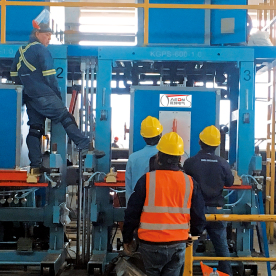In today’s fast-paced industrial landscape, efficiency, precision, and reliability are paramount. As manufacturers strive to elevate their production capabilities, the importance of innovative technologies cannot be overstated. One such innovation making significant waves in the manufacturing sector is the solid state high frequency welder machine. This sophisticated machinery is revolutionizing the way metal components are joined together, setting new standards in quality and efficiency.
The solid state high frequency welder machine utilizes advanced semiconductor technology to deliver stable and precise welding operations. Unlike traditional welding machines that rely on vacuum tubes, solid state technology provides several advantages that enhance the welding process. These machines operate at high frequencies, allowing for faster welding speeds and significantly reduced cycle times. This efficiency is particularly crucial for industries that require high-volume production, such as automotive manufacturing, electronics, and heavy machinery.
One of the standout features of solid state high frequency welders is their ability to maintain consistent power outputs. This is achieved through digital control systems that monitor and adjust the welding parameters in real time. As a result, manufacturers benefit from improved weld quality, as the consistent heat and pressure applied during the welding process lead to stronger joints with fewer defects. This increased reliability reduces waste and rework, ultimately contributing to higher profitability and less environmental impact.

The Revolutionary Impact of Solid State High Frequency Welder Machines on Modern Manufacturing Processes
Moreover, the compact design of solid state high frequency welder machines allows for greater flexibility on the manufacturing floor. Their smaller footprint compared to traditional machines makes it easier to integrate them into existing production lines or to utilize them in applications where space is limited. Additionally, the lower maintenance requirements associated with solid state technology can lead to reduced downtime. Traditional machines often require regular upkeep of vacuum tubes and related components, which can lead to disruptions in workflow. Solid state machines, on the other hand, are designed to operate with less intervention, maximizing productivity.
The versatility of solid state high frequency welders also plays a critical role in their growing popularity. They are capable of welding a wide array of materials, including ferrous and non-ferrous metals, plastics, and even composite materials. This capability makes them particularly valuable in diverse industries where different materials need to be joined quickly and effectively. Furthermore, their ability to handle thin gauges of materials reduces the risk of warping or distortion, which is often a concern with traditional welding methods.
In terms of energy efficiency, solid state high frequency welder machines also stand out. Their design allows for lower energy consumption during operation, which not only contributes to cost savings but also aligns with the increasingly important goal of sustainable manufacturing practices. Higher energy efficiency translates to reduced carbon emissions and a lower overall environmental footprint, making them an attractive option for companies looking to enhance their green credentials.

The Revolutionary Impact of Solid State High Frequency Welder Machines on Modern Manufacturing Processes

The Revolutionary Impact of Solid State High Frequency Welder Machines on Modern Manufacturing Processes
Safety is another vital consideration in manufacturing environments, and solid state high frequency welders help address this concern effectively. These machines are equipped with advanced safety features that help protect operators from potential hazards typically associated with welding, such as harmful radiation and extreme temperatures. Enhanced safety protocols can lead to a more secure working environment, promoting employee well-being and reducing liability for manufacturers.
As industries continue to evolve, the adoption of technologies like the solid state high frequency welder machine will become even more essential for businesses aiming to maintain a competitive edge. The combination of enhanced welding precision, improved cycle times, and reduced environmental impact positions these machines as a cornerstone of modern manufacturing processes.
In conclusion, the solid state high frequency welder machine is not just a technological advancement; it represents a transformation in the way manufacturers approach welding and assembly. As the push for higher productivity, lower costs, and sustainable practices intensifies, forward-thinking industries will increasingly rely on this cutting-edge equipment to meet their objectives. The future of welding is undoubtedly bright, with solid state technology leading the charge into a new era of manufacturing excellence.Reliable Annealing Machine Replacement Components


